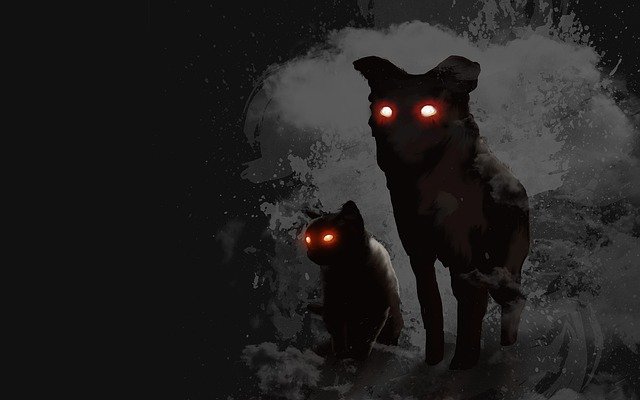
31 May Blink Dog: Heckin Teleporty Doge
Blink dogs can zap in and out of existence, teleporting around a fight to deal damage and then flick away again. Just when you think you’ve got a chance to hit it back, it disappears again.
What is a blink dog?
A blink dog takes its name from its ability to “blink” in and out of existence, literally teleporting around to zap in and out of battle.
This allows it to deal attacks and to avoid getting hit by blinking away. Appearing and disappearing is a powerful tool that lets a blink dog hold its own in a fight, even outnumbered.
How big is a blink dog?
Blink dogs are medium size, which technically means they occupy a 5 ft by 5 ft square, just like humans, elves, humanoids etc etc. But in reality they are the size of a medium to large dog. Think doberman or malamute, but with bigger ears and better stats.
What do Blink dogs eat?
Meat! Dogs are obligate carnivores, and, while they can eat the occasional plant to supplement their diet, they need to eat meat to live. Blink dogs hunt small game in the wild, or if they’re in a pack they may work together to bring down larger prey.
If they are with a companion, their companion will know all the choice spots in town to get the blink dog meat scraps for cheap, bones for chewing, and all the gristle and other bits that the butcher can’t sell for more discerning palates.
Making friends with a blink dog may be easier if you have a nice big bone full of marrow to offer it (more on that later).
What are blink dog powers?
Blink dog: medium, fey, lawful good, armor class 13, hit points 22 (4d8+4)
Faster than you: speed 40 ft.
STR 12 (+1), DEX 17 (+3), CON 12 (+1), INT 10 (+0), WIS 13 (+1), CHA 11 (+0)
Skills: Perception +3, Stealth +5
Senses: Passive Perception: 13
Languages: Blink Dog, Understands Sylvan but can’t speak it
Challenge: 1/4 (50 XP) (not too bad on their own but any size pack of them will cause you to have a fairly large problem on your hands)
- Keen Hearing and Smell. The dog has advantage on Wisdom (Perception) checks that rely on hearing or smell.
V.3.5 of the Monster Manual said that they had lowlight or even darklight vision, but that was dropped, and in 5e they don’t specifically have any extra ability to see in the dark, but does have the aforementioned special abilities with hearing or smell.
Actions:
- Bite. Melee Weapon Attack: +3 to hit, reach 5 ft., one target. Hit: 4 (1d6 + 1) piercing damage.
- Teleport (Recharge 4-6). The dog magically teleports, along with any equipment it is wearing or carrying, up to 40 feet to an unoccupied space it can see. Before or after teleporting, the dog can make one bite attack.
Think about that teleport power for a sec.
You are standing there in the middle of a fight, trying to make sure you pick a good target to help your party get out of this alive, and then BAM! Outta literally nowhere, a magical dog wearing a bunch of dog armor appears and bites you.
Or just as bad: you see it coming, brace yourself, get bitten, and then BAM! It disappears before you can hit it back! What the hell man, how are you supposed to fight that?
Are blink dogs pets?
I am of the opinion that anything can be a pet if you try hard enough, but your DM may differ. Certainly when you look at their history, you can make a case for being able to have one, especially if you have some fey connection. For that, you need to know about displacer beasts.
Displacer beasts, resembling a sleek great cat covered in blue-black fur with six legs and the two tentacles sprouting from their shoulders, glowing eyes, and an evil bent, roamed the twilight lands of the Feywild for ages.
They were captured and trained by the Unseelie Court, whose warriors selectively bred the beasts to reinforce their ferocious and predatory nature. They used them to hunt unicorns, pegasi, and other wondrous prey.
However, it didn’t take long for the Unseelie Court to lose control; the displacer beasts used their malevolent intelligence to escape their masters. Living and breeding freely in the Feywild, the displacer beasts soon came to the attention of the Seelie Court.
Using their blink dog companions, fey hunters drove these predators to the fringes of the Feywild, where many crossed over to the Material Plane.
To this day, the history between them is remembered to the core of their being: displacer beasts and blink dogs attack each other on sight.
Are there dogs in D&D?
Yes! There’s even a mastiff with stats in the monster manual:
Mastiff: Medium beast, unaligned.
Armor Class: 12, Hit Points: 5 (ld8 + 1), Speed: 40 ft.
STR: 13 (+1), DEX: 14 (+2), CON: 12 (+1), INT: 3 (-4), WIS: 12 (+1), CHA: 7 (-2)
Skills: Perception: +3, Passive Perception: 13
Languages – bark bark, woof bark!
Challenge 1/8 (25 XP)
Keen Hearing and Smell: Mastiffs have advantage on Wisdom (Perception) checks that rely on hearing or smell. If there’s some element of the passive perception at play that produces smell or sound, a mastiff will be all over it!
Actions: Bite. Melee Weapon Attack: +3 to hit, reach 5 ft ., one target. Hit:4 (1d6 + 1) piercing damage. If the target is a creature (and not, for instance, a stick), it must succeed a DC 11 Strength saving throw or be knocked prone.
Mastiffs are impressive hounds prized by humanoids for their loyalty and keen senses. They can be trained as guard dogs, hunting dogs, and war dogs. Halflings and other small humanoids can ride them as mounts!
Can you have an animal companion in D&D?
Oh yes! I have seen whole parties where every player had their own animal companion helper, and it was very cool to see how everyone tried to use them to help in various inventive ways to solve problems differently.
An owl for nighttime surveillance, a backpack full of lizards to help create distractions, a rescued baby bear as a mascot to win the favour of the town.
There are many possibilities, but with every cool thing, your DM isn’t just going to let you have it; you must do your research and show that you know what it would mean to care for the animal companion, what it needs to eat, how to armor it so it doesn’t die if you’re taking it into a fight, and how other people and animals interact with it.
What pets can you have in D&D?
There exists a lot of homebrew around Animal Companion / Pet Companion, and you’ll have to hash it out with your DM about what you want to do and how it’s going to work.
You can make a pretty easy case to have a regular, mundane, ordinary pet. You know, just a cat or a dog that chills back at the headquarters while your party is out slaying monsters and going on adventures.
Who is going to take care of your pet while you are away? Is your pet going to be lonely waiting for you to return? Is the adventuring life really suited to owning an animal who relies on you for food, shelter, and companionship?
If you do get a pet, you will be tempted to take it with you wherever you go. This is understandable, but also realise that your pet is defenceless and useless in a battle.
You will have to make sure there is a safe spot to stay out of the way while you are in danger, or you’re going to lose it.
So you want to be a Beast Master
If you are a Ranger, consider the Beast Master archetype, from the D&D Players Handbook:
The Beast Master archetype embodies a friendship between the civilized races and the beasts of the world. United in their focus, beast and ranger work as one to fight the monstrous foes that threaten civilization and the wilderness alike.
Emulating the Beast Master archetype means committing yourself to this ideal, working in partnership with an animal as its companion and friend.
At 3rd level, you gain a beast companion (more than a pet!) that accompanies you on your adventures and is trained to fight alongside you. Choose a beast that is no larger than medium and that has a challenge rating of 1/4 or lower.
Add your proficiency bonus to the beast’s AC, attack rolls, and damage rolls, as well as to any saving throws and skills it is proficient in. Its hit point maximum equals its normal maximum or four times your ranger level, whichever is higher.
The beast obeys your commands as best as it can. It takes its turn on your initiative, though it doesn’t take an action unless you command it to. On your turn, you can verbally command the beast where to move (no action required by you).
You can use your action to verbally command it to take the Attack, Dash, Disengage, Dodge, or Help action. Once you have the Extra Attack feature, you can make one weapon attack yourself when you command the beast to take the Attack action.
While travelling through your favored terrain with only the beast, you can move stealthily at a normal pace.
If the beast dies (;_;), you can obtain another one by spending 8 hours magically bonding with another beast that isn’t hostile to you, either the same type of beast as before or a different one.
Consider the following for your options:
Baboon, Badger, Bat, Blood Hawk, Boar, Cat, Crab, Deer, Eagle, Flying Snake, Frog, Giant Badger, Giant Centipede, Giant Crab, Giant Fire Beetle, Giant Frog, Giant Poisonous Snake, Giant Rat, Giant Weasel, Giant Wolf Spider, Goat, Hawk, Hyena, Jackal, Lizard, Mastiff, Mule, Octopus, Owl, Panther, Poisonous Snake, Pony, Pteranodon, Quipper, Rat, Raven, Scorpion, Sea Horse, Spider, Stirge, Weasel, Wolf.
Depending on your character, you can get some pretty cool synergy going with your beast companion. A Dragonborn with a lizard hanging out on his shoulder would be pretty neat. An Aarakocra with a blood hawk or an owl would be a cool combo.
A gnome might want something she could use as a mount, so perhaps a giant badger would be a fierce companion!
So that’s about blink dogs and some animal companion stuff thrown in to boot!
At the end of the day, your DM will be calling the shots about what you are and aren’t allowed to be doing, so make sure to check with them before you make moves to tame a blink dog and make it part of your adventuring party.
Stavros

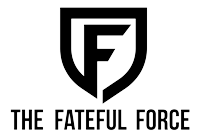
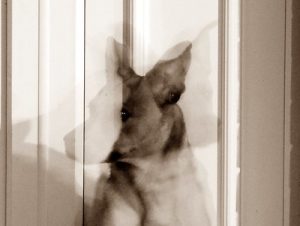
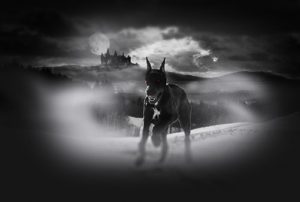
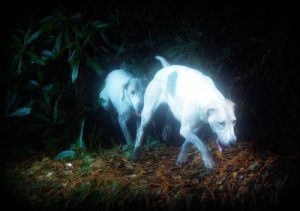

No Comments